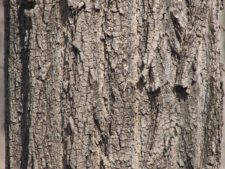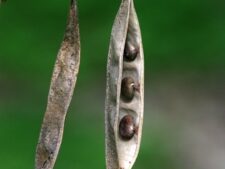
This medium-sized tree has a rough, scaly bark (B). The branches have spines (A). The compound leaves have up to 21 rounded leaflets (A). The white, fragrant legume flowers form drooping racemes (A). The fruit is a pod with 3-8 brown, kidney-shaped seeds (C).
This tree is native to a portion of the southeastern United States, but has become invasive in many parts of the country outside its native range, including the Midwest. This tree is sometimes confused with the native Honey Locust (Gleditsia triacanthos). Black Locust leaflets are larger and more rounded than Honey Locust, and their seed pods are generally shorter and thicker than Honey Locust’s. It also has thicker, more deeply furrowed bark than Honey Locust, which has flatter, more plate-like bark.
This tree is locally common along History Trail, flowering in May. It was planted there long ago and is propagating there mainly from root sprouts.
Black Locust at Fontenelle Forest is being treated by mowing or cutting and treating with herbicide.
The content of NatureSearch is provided by dedicated volunteer Naturalists of Fontenelle Forest who strive to provide the most accurate information available. Contributors of the images retain their copyrights. The point of contact for this page is: Roland Barth.


